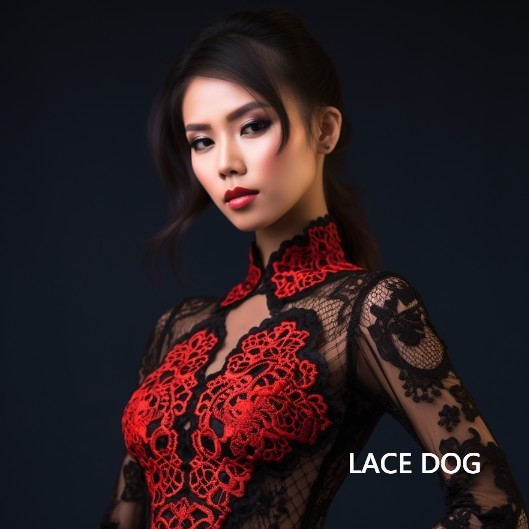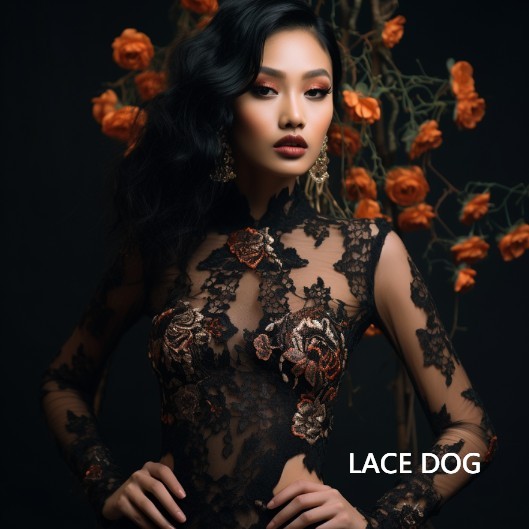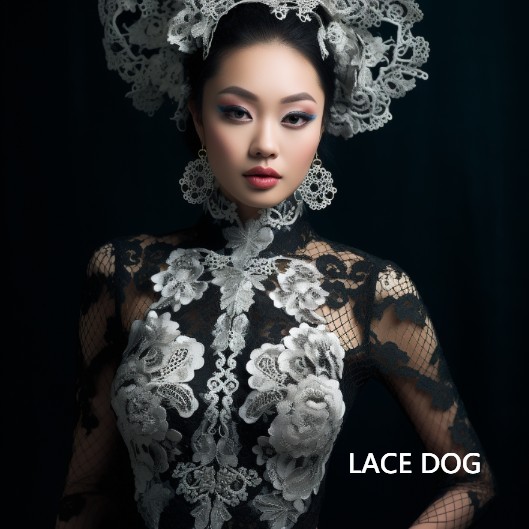Laced with Intrigue: A Grand Tour of Global Lace Embroidery
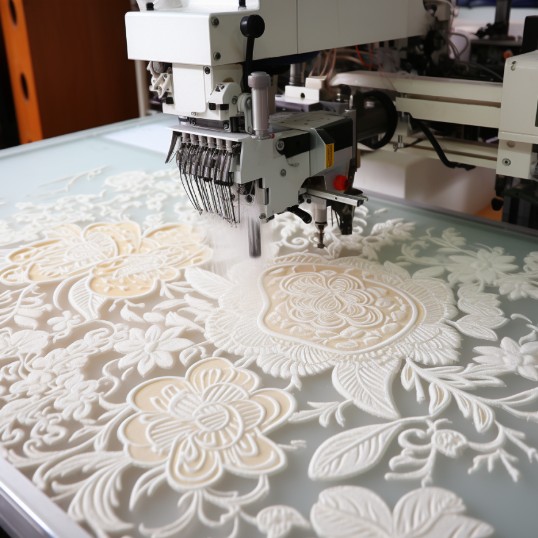
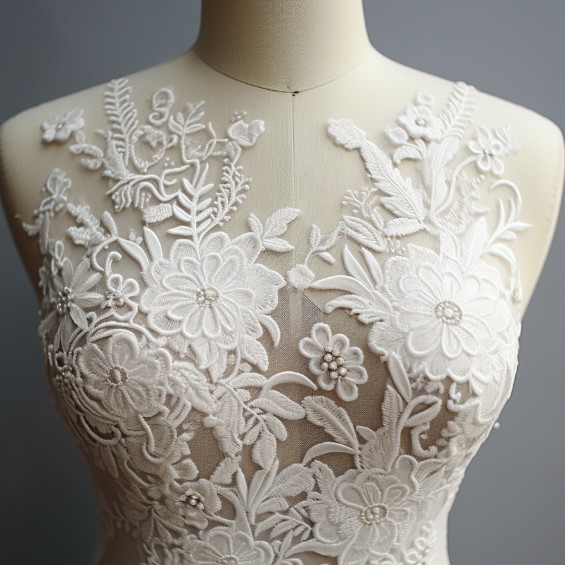
Good day, dear web wanderer! Prepare to be dazzled as we embark on a whirlwind, international journey through the rich, intricate world of lace embroidery. With over 20 years as a lace manufacturing powerhouse, we’ve spun many a tale of thread and tradition. Grab your passports, fellow threadheads! It’s time to explore the craftsmanship, history, and diversity of lace across the globe.
Chapter One: The Majestic Heavyweights of Lace Our tour begins with the crème de la crème of lace making nations: France, Belgium, India, China, and the United States. Each country adds its unique thread to the global lace tapestry, creating a beautiful, interconnected design.
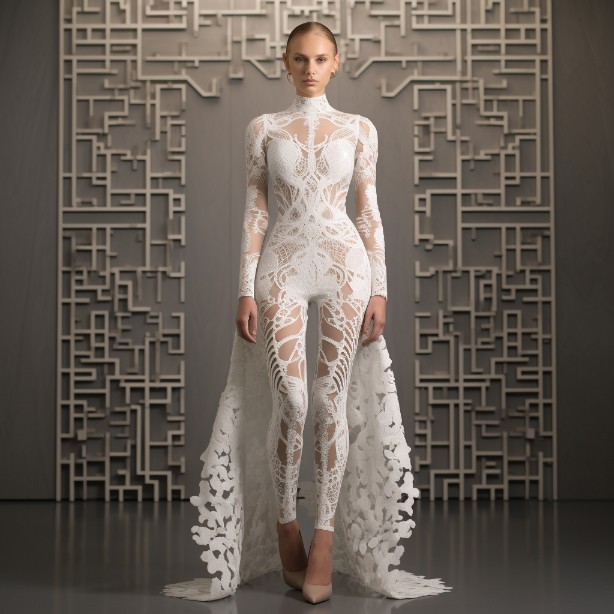
“Behold the timeless elegance of lace! French whispers sophistication, British embodies tradition, Italian reveals romance. Our Chinese lace, a bridge between past and present. Each stitch, a cultural echo. Not just fabric, but history woven into art. The model’s adornment, lace takes center stage, captivating all with its ethereal beauty!”
France: The Aristocrat of Lace
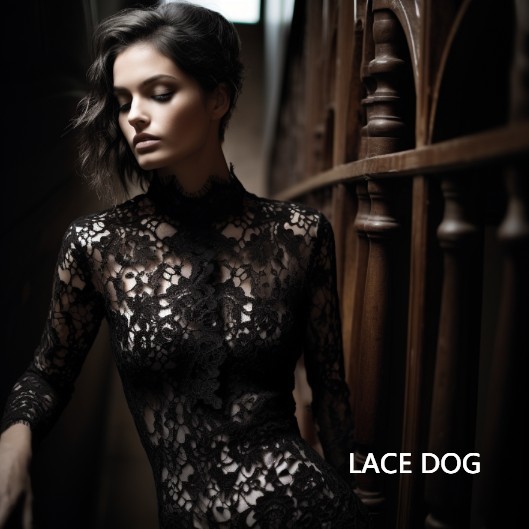
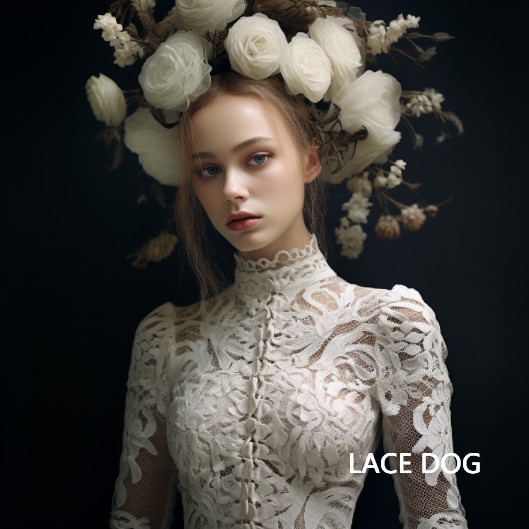
Our first stop is the birthplace of lace – France. French lace, known for its high-quality threads and traditional designs, exudes elegance and refinement. From the lush vineyards of Champagne to the romantic banks of the Seine, you’ll find the exquisite Chantilly and Alençon lace, renowned for their luxurious quality and intricate craftsmanship. But as with most high-class affairs, you should be prepared to spend a few extra bucks.
Lace, a delicate fabric with a long history of beauty and craftsmanship, found its most famed expression in France. This intricate art form, though steeped in tradition, has kept pace with fashion’s changing tides, with French lace maintaining a lofty pedestal in the world of high-end couture and design.
In the bustling streets of Paris, artisanal workshops keep alive the centuries-old methods of lacemaking. The skilled hands of these artisans weave magic in silk threads, painstakingly creating motifs and patterns that make French lace an object of desire. This attention to detail and the painstaking effort that goes into producing each metre of lace render it a masterpiece of aesthetic and functional art.

French lace modeling exhibits unparalleled sophistication and grace. This delicate fabric, traditionally made by skilled artisans, imbues an air of romantic elegance to any outfit. The intricate patterns and exquisite detailing speak volumes about France’s rich textile history. The sophistication of French lace lends itself effortlessly to high-fashion, enhancing the model’s allure with its refined charm.
Notably, Chantilly and Alençon, two regions in France, are celebrated for their unique lace styles. Chantilly lace, known for its fine detailing and soft drape, features delicate, complex patterns woven with meticulous precision. On the other hand, Alençon lace, often termed as the “Queen of lace,” offers a rich, textured feel with its distinctive raised cording. The beauty of these styles lies in their timelessness – they hold as much appeal to the contemporary designer as they did to the nobles of the yesteryears.
French lace, with its sheer, ethereal quality, is often the fabric of choice for wedding gowns, evening dresses, and lingerie. Its ability to blend tradition and modernity, its delicate balance of opulence and simplicity, make it a favorite among designers worldwide. Whether it’s a detail on a Dior gown or an accent on a Chanel ensemble, French lace adds a touch of elegance and sophistication that few other fabrics can match.
Lace connoisseurs will appreciate that investing in French lace is not merely a purchase; it is partaking in a legacy. Each thread weaves a story, each pattern narrates a history, and owning a piece of French lace means becoming a part of that rich tapestry. And as such, the investment is well worth it.
In essence, French lace is more than just fabric; it is a testament to the country’s love for craftsmanship, art, and beauty. And even though it might require a higher budget, the end product is nothing short of breathtaking, making it a true luxury to behold and treasure.
Firstly, French lace is known for its high cost, which can be a barrier for many customers. The use of the finest materials, combined with meticulous hand-crafting techniques, results in a costly product. While the quality is unquestionably high, it can put French lace out of reach for some segments of the market.
The second drawback is linked to the production time. Traditional French lacemaking is a labor-intensive process that requires a high degree of skill and time. This slow production rate can be a challenge in the fast-paced world of fashion, where trends shift rapidly and demand quick turnaround times.
Thirdly, the reliance on traditional methods may limit innovation. While the classic styles of Chantilly and Alençon lace are timeless, there’s a risk of being seen as outdated in a market where innovation and novelty often drive consumer interest. The French lace industry may need to strike a balance between maintaining their heritage and evolving to meet modern design trends.
Moreover, the versatile nature of French lace allows for a multitude of applications. From intricate bridal gowns to fashionable haute couture pieces, it is the epitome of luxury and refinement. Worn by a model, it highlights the figure gracefully, offering a balance between opulence and delicate subtlety. It’s no wonder that French lace has become a timeless symbol of style and elegance on the global fashion stage.
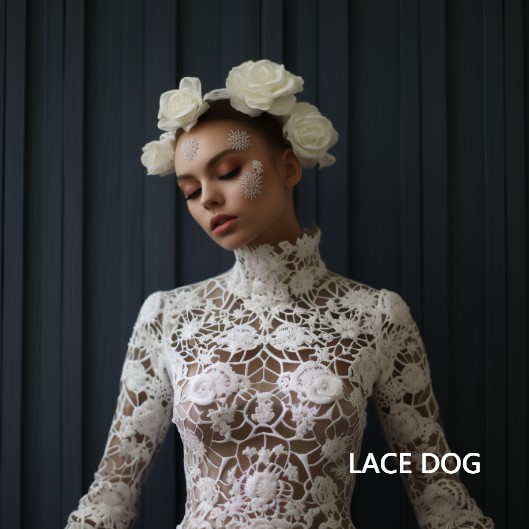
Lastly, there’s a challenge tied to the preservation of this craft. As with many artisanal trades, lacemaking is facing a skills shortage. With fewer people taking up this craft, there’s a risk that the intricate skills and knowledge could be lost over time.
Despite these challenges, the French lace industry continues to thrive, largely due to the sheer quality of the product and the high regard for this luxury material in the fashion world. To maintain this position, it’s important for the industry to address these limitations and adapt to changing market dynamics, perhaps by integrating new technology or innovating in design while preserving the core of this centuries-old craft.
India: The Jewel in the Crown of Affordability
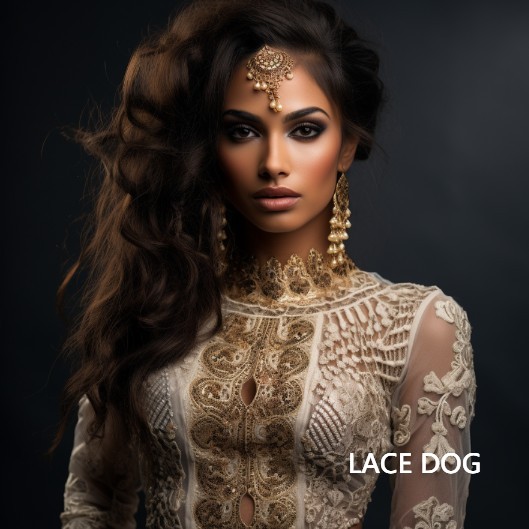
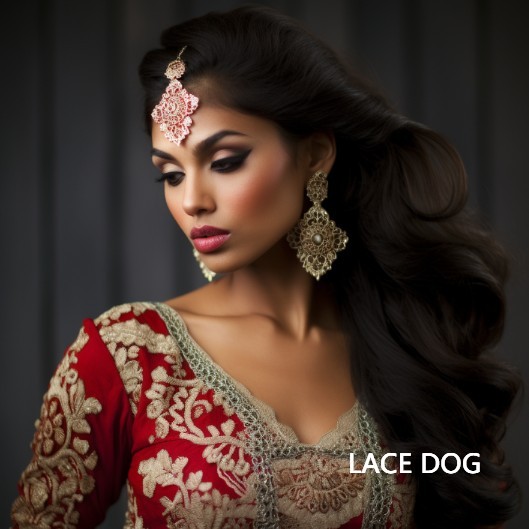
Embracing the flamboyant spirit of its homeland, Indian lace displays a tantalizing blend of diverse cultural influences. This diversity is reflected in the plethora of colors, patterns, and styles that Indian lace has to offer, making it a compelling choice for those seeking an eclectic mix in their designs.
India’s lace industry, much like its famed Bollywood, relies on a large workforce, which translates to high-volume production. This manufacturing capacity allows the Indian lace industry to meet substantial demand while maintaining competitive pricing. It’s an advantage in a price-sensitive market, making Indian lace an attractive choice for both domestic and international buyers.
The Indian lace industry is also notable for its willingness to experiment. Infusing the vibrancy of the country’s multiple cultures, Indian lace often features bold patterns and a riot of colors that can add a unique aesthetic to any design. This variety can be particularly appealing to fashion and interior designers looking for a distinctive, ethnic touch.
On the flip side, one of the challenges the Indian lace industry faces is inconsistency in quality. While there are producers who maintain high standards, there are others where quality can vary greatly, sometimes even within the same batch. This unpredictability is reminiscent of a spicy Indian curry – enticingly vibrant, but with results that can be a hit or miss.
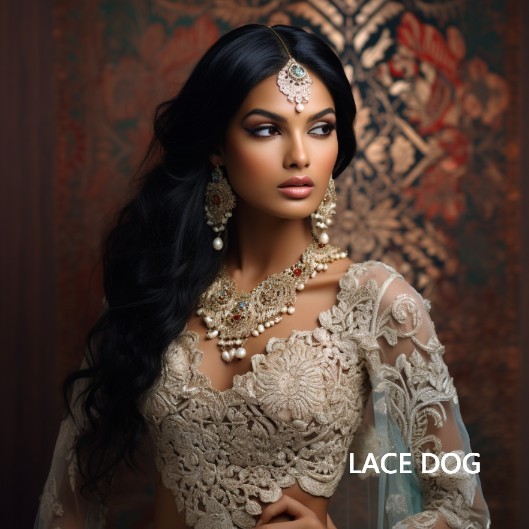
Indian lace modeling brings together tradition and modernity in a unique fusion. The intricate detailing of lace complements India’s vibrant textile heritage, creating stunning designs that blend the classic with the contemporary. Worn by a model, Indian lace breathes life into any ensemble, its complex patterns reflecting India’s rich cultural diversity. This unique versatility of Indian lace allows it to seamlessly blend into various attire, from traditional sarees to modern couture.
Another challenge lies in standardization. With a vast number of small-scale manufacturers, achieving consistent standards across all production units can be difficult. This can result in significant variations in design, color, and quality, which can pose a challenge for designers and retailers looking for consistency in their collections.
Labour conditions in the industry also pose a concern. A significant portion of lace production in India occurs in small-scale, sometimes home-based units, and the welfare of the workers in these units, including fair wages and safe working conditions, is an ongoing issue.
Lastly, environmental impact is another concern. The textile industry in general has a high environmental footprint, and the lace industry is no exception. The use of synthetic dyes and wasteful production practices in some units can lead to significant environmental harm.
In addition, the amalgamation of lace with Indian fabrics like silk or cotton adds a layer of depth and texture, enhancing the visual appeal. The contrasting interplay of the delicate lace with these robust materials creates a remarkable aesthetic, making it a favorite on the fashion runway. When draped on a model, it accentuates the silhouette, adding a dash of elegance and a hint of mystique to the overall look. Indian lace, therefore, is not just a fabric, but a vibrant narrative of India’s fashion story.
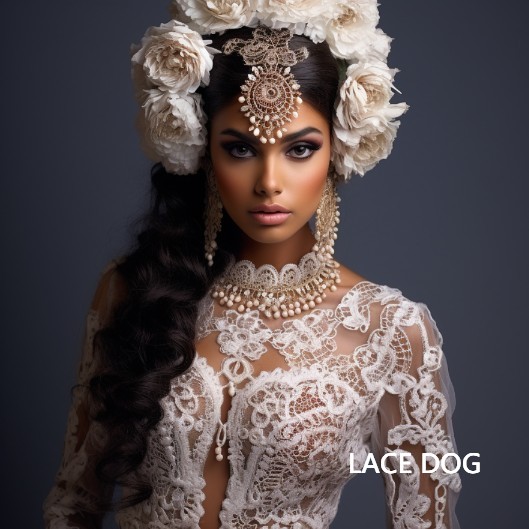
Despite these challenges, the Indian lace industry is a dynamic and vibrant part of the global textile market. With its rich diversity, capacity for high-volume production, and competitive pricing, it holds a significant place in the global lace landscape. However, improvements in quality control, labor practices, and environmental sustainability are needed to enhance its reputation and sustainability for the future.
Turkey: The Oriental Charm

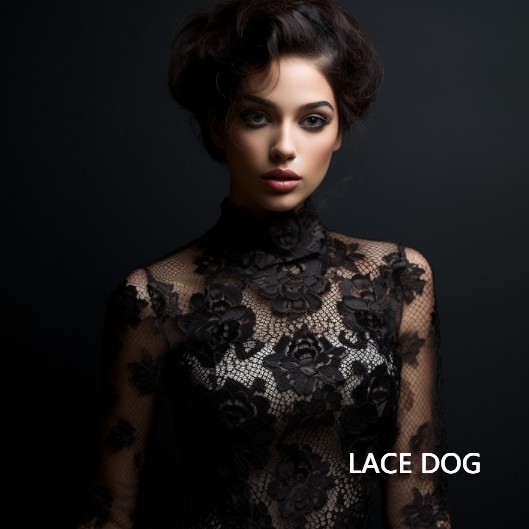
Like the country itself, a magnificent blend of East and West, Turkish lace embodies a fusion of diverse influences. The result is a unique style that holds appeal for a broad range of tastes.
Turkish lace production, benefiting from its strategic location and rich cultural heritage, has successfully combined affordability with mass production, much like the country’s popular praline honey cakes. This allows Turkish lace to satisfy a larger market segment seeking affordable, yet appealing lace fabric.
Turkey’s lace manufacturing sector has matured over time, adopting modern machinery and techniques, which has significantly increased its output. This high volume production, paired with reasonable pricing, positions Turkish lace as an attractive option for designers and retailers on a budget.

Modeling in Turkish lace is a captivating showcase of cultural heritage intertwined with contemporary fashion. Turkish lace, with its Ottoman-inspired patterns, adds a dimension of historical richness to any outfit. On a model, it emphasizes an exotic allure, transforming the runway into a narrative of Turkey’s illustrious past and dynamic present. The beauty of Turkish lace lies in its flexibility – it complements both traditional ‘kaftans’ and modern styles, a testament to its universal appeal.
The stylistic versatility of Turkish lace is another strong suit. It reflects the country’s historical and cultural melange, with designs ranging from the traditional motifs influenced by Ottoman aesthetics, to contemporary patterns that resonate with global trends. This versatility allows Turkish lace to find its place in various applications, from clothing and home decor to accessories.
However, like a slice of praline honey cake that leaves some dessert connoisseurs yearning for richer flavors, Turkish lace, too, may not meet the expectations of all. One critique often pointed towards Turkish lace is that, in its pursuit of affordability and high-volume production, it can sometimes lack the intricate detailing and rich texture that more luxurious laces, like French lace, provide.
Additionally, while modern manufacturing techniques have enabled mass production, they have also led to a reduced emphasis on traditional hand-crafted techniques. This shift may cause a loss of unique, artisanal quality in some Turkish lace products.
Lastly, though quality control has improved with modern machinery, it can still be inconsistent. As with any industry that caters to mass production, maintaining a consistent quality across all products can be a challenge, and the Turkish lace industry is no exception.
Moreover, Turkish lace is known for its remarkable quality and distinct designs. The intricate details of the lace, accentuated by bright colors and motifs, breathe life into the fabric, making it stand out on the fashion stage. When a model wears Turkish lace, it enhances her aesthetic appeal, creating a blend of sophistication and distinctive charm. It’s no surprise, then, that Turkish lace continues to enchant onlookers, beautifully merging the lines between tradition and trend

In conclusion, Turkish lace offers a blend of affordability, stylistic diversity, and mass availability that makes it appealing to a wide market. However, to elevate its standing in the global lace arena, it could benefit from focusing on enhancing its artisanal qualities and maintaining consistent quality across its product range.
Switzerland: The Timekeeper of Lace
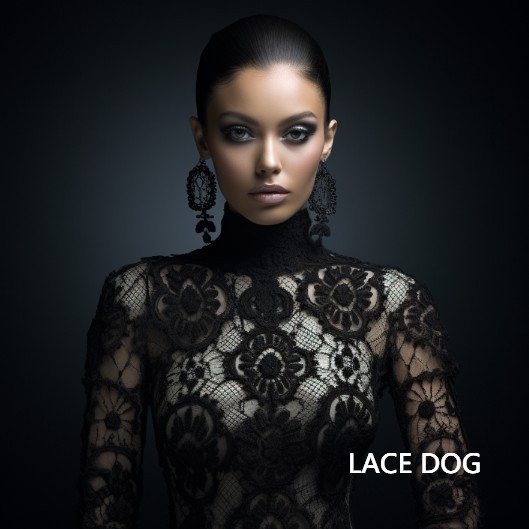

In the pristine environment of the Swiss Alps, where precision is inherent in every aspect of life, Swiss lace represents the zenith of luxury, craftsmanship, and quality. Just as Swiss timepieces are the epitome of horological perfection, Swiss lace holds a similar reverence in the luxury fabric market.
One of the distinctive strengths of Swiss lace is the unparalleled craftsmanship it demonstrates. Much like the intricate workings of a Swiss watch, Swiss lace is woven with meticulous precision, resulting in patterns that are intricate, sophisticated, and consistently flawless.
High quality is another hallmark of Swiss lace. Swiss manufacturers, known for their stringent quality standards, use only the finest materials in the production of lace. This ensures that the resulting fabric is not only visually appealing but also durable and comfortable for the wearer.

Swiss lace modeling embodies classic European elegance with a subtle touch of modernity. Swiss lace, renowned for its exceptional quality and precision, adds a refined sophistication to any ensemble. When a model adorns Swiss lace, it accentuates the silhouette, offering a pristine and polished look. This fine fabric, with its intricate yet minimalist design, effortlessly enhances both haute couture and ready-to-wear collections, making Swiss lace a perennial favorite on the runway.
The precision and quality embodied in Swiss lace make it a much sought-after fabric in the high-end fashion industry. From haute couture gowns to luxury bridal wear, Swiss lace is often the fabric of choice for designers who value finesse and quality above all.
However, such precision and high quality come at a cost. Swiss lace, like its horological counterparts, is known for its high price point. The investment in fine materials, meticulous craftsmanship, and stringent quality control procedures means that Swiss lace is priced at a premium. As such, it might not be the go-to choice for those working within tight budget constraints.
Moreover, while Swiss lace’s emphasis on traditional, high-quality craftsmanship is commendable, it may face challenges in a fast-paced industry that values quick turnarounds and trend-responsive designs. The time-intensive processes involved in producing Swiss lace could potentially limit its ability to meet high volume or rapid demand.
Swiss lace’s versatility is one of its key strengths. It can be seamlessly incorporated into a variety of styles, from chic daywear to extravagant evening gowns. On a model, the delicacy of Swiss lace adds an aura of understated luxury, exuding an air of grace and poise. Its unique balance between time-honored tradition and contemporary design makes Swiss lace an enduring symbol of style and elegance in the global fashion industry.

In summary, Swiss lace is an embodiment of the country’s dedication to precision, high-quality materials, and exceptional craftsmanship. It caters to a niche, luxury market that values these characteristics. However, its high cost and potentially slower production times could be limiting factors in its broader market appeal. For those who can appreciate and afford its sublime quality, Swiss lace represents the pinnacle of fabric luxury.
Chapter Three: Korea – The Tech-Savvy Tastemaker in Lace
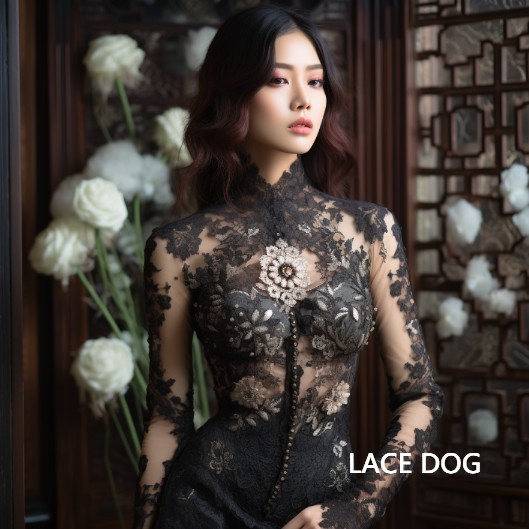

As we continue our enchanting tour of lace, let’s hone in on Korea, a country that beautifully marries tradition and technology. Known as much for its pop culture and spicy cuisine as for its innovative approach to industries, Korea’s place in the lace world is both vibrant and dynamic.
Korea’s prowess in the lace market can largely be attributed to its adoption of advanced technology. The country’s lace manufacturers are not shy about incorporating cutting-edge machinery and techniques into their production process. This use of technology results in impressive efficiency and precision, which in turn leads to consistent, high-quality lace products.
Another standout feature of Korean lace embroidery is its distinct design aesthetic. Drawing inspiration from both traditional Korean motifs and modern trends, Korean lace strikes a unique balance between old and new. This blend of tradition and trendiness results in products that can appeal to a wide range of consumers, from those seeking a touch of the classic to those desiring something more contemporary.
Moreover, Korea’s reputation for quality extends beyond just the manufacturing process. The country’s rigorous quality control standards ensure that every piece of lace that leaves the production line is nothing short of excellent. This commitment to quality helps bolster the global perception of Korean lace products as being dependable and well-made.
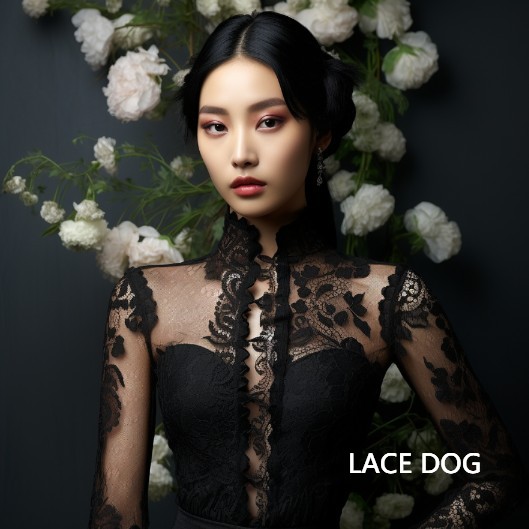
Korean lace modeling merges traditional elegance with trendy K-fashion. The unique blend of intricate lace patterns with the contemporary flair of Korean style creates an aesthetically appealing sight on the runway. On a model, Korean lace enhances a chic and youthful look, capturing the vibrant spirit of Seoul’s bustling fashion scene. The fusion of the delicate fabric with Korea’s dynamic style trends offers an edge that is both innovative and distinctly Korean.
However, like any country’s lace industry, Korea’s is not without its challenges. The country’s innovative and technologically advanced approach, while yielding numerous benefits, also incurs higher production costs. These costs, in turn, make Korean lace products more expensive than those from some other countries. This price differential can make it difficult for Korean lace to compete in markets where cost is a significant factor.
Additionally, while Korea’s modern take on lace is appealing to many, it might not resonate with purists who prefer more traditional styles of lace embroidery. The country’s emphasis on technology and innovation can sometimes overshadow the traditional aspects of lace making, making it less appealing to those who value historical designs and techniques.
Korean lace’s adaptability is remarkable. From styling it with Hanboks – traditional Korean attire – to incorporating it in modern-day fashion, the fabric adds a delicate sophistication. On a model, it accentuates the silhouette, offering a balance between the traditional and the modern. This balance, a hallmark of Korean fashion, highlights the country’s ability to retain cultural identity while embracing global fashion trends, making Korean lace a standout element on the international fashion stage.

In summary, Korea’s lace industry is a powerful testament to the country’s technological prowess and its ability to innovate. With its high-quality products, unique design aesthetic, and commitment to excellence, Korea continues to make significant contributions to the global lace market. Despite facing challenges in terms of cost and catering to the tastes of traditionalists, the future of Korean lace looks bright and promising. As we watch this dynamic country continue to weave its story in the grand tapestry of lace, we can’t help but feel excited about what the next chapter will hold.
Chapter Four: China – The Colossal Dragon of Lace
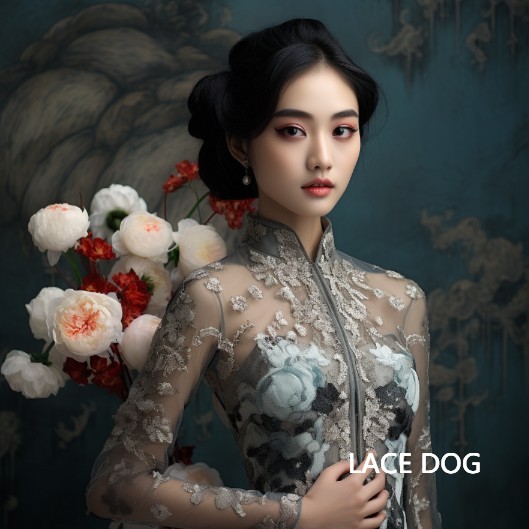
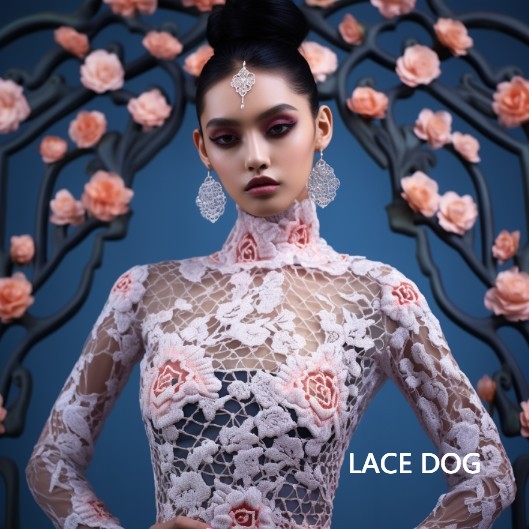
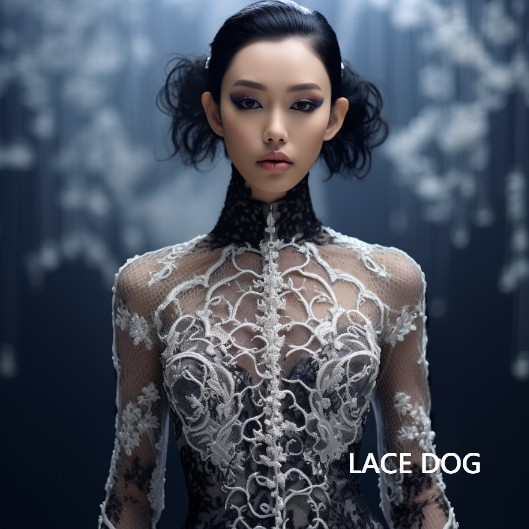
As we weave our way through the world of lace, we arrive at China, a powerhouse of manufacturing that has left an indelible imprint on the global lace market. With its large-scale production capabilities, competitive pricing, and the relentless pursuit of quality, China is a fascinating tapestry of tradition and modernity in lace production.
China’s strength in the lace market starts with its sheer production volume. As the largest manufacturer in the world, China has a deep pool of resources and a massive workforce that enables it to churn out enormous quantities of lace. This capacity to produce at such a grand scale provides China with a significant edge, allowing it to meet global demands swiftly and efficiently.
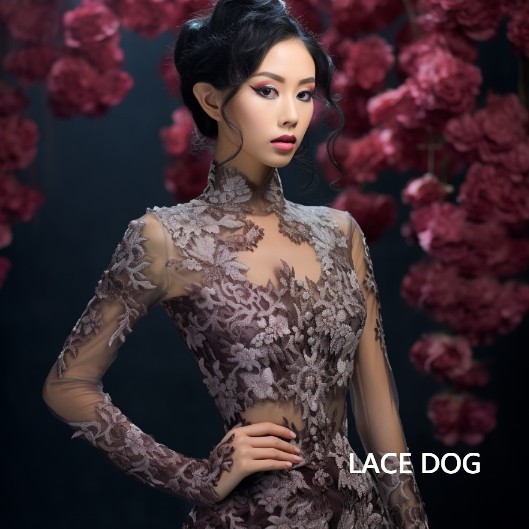
Chinese lace modeling is a magnificent blend of heritage and innovation. Steeped in thousands of years of textile tradition, Chinese lace exudes a sense of elegant charm and refined grace. On a model, it presents an aura of mystique and allure, narrating stories of ancient craft juxtaposed with modern designs. The intricate patterns, deeply rooted in Chinese symbolism, add a layer of cultural depth to any attire, from traditional Cheongsams to contemporary fashion.
The affordability of Chinese lace is another compelling advantage. By leveraging economies of scale, China can produce lace at a cost that few countries can match. This competitive pricing is a boon to buyers, particularly in markets where cost plays a vital role in purchasing decisions.
Furthermore, China’s lace industry has made remarkable strides in enhancing the quality of its products. While China may have been viewed in the past as a source of inexpensive but lower-quality lace, it’s an image that’s rapidly evolving. The Chinese lace industry has been investing heavily in technology and training to improve both the quality of the lace and the perception of Chinese lace on the world stage.
Further, the adaptability of Chinese lace transcends sartorial boundaries. It can be employed effectively in both luxurious ceremonial attire and everyday wear. As a model showcases Chinese lace, it accentuates her silhouette, highlighting an elegant blend of historical richness and contemporary style. In essence, Chinese lace is a testament to China’s vast cultural heritage, seamlessly woven into the threads of global fashion trends.
However, despite these significant strengths, China’s lace industry also faces its own set of challenges. One of the main concerns is the perception of quality. Despite improvements, Chinese lace is often perceived as being of lower quality compared to lace from countries such as France or Belgium. Addressing this perception is a priority for China as it strives to elevate its standing in the global lace market.
Additionally, Chinese lace, while improving in quality and variety, has not traditionally been associated with unique or intricate designs. The emphasis on large-scale production and cost efficiency sometimes resulted in a lack of traditional or innovative design. However, this is rapidly changing as the Chinese lace industry embraces technology and design innovation, striving to offer a broader variety of designs that cater to diverse global tastes.
In essence, China’s lace industry is a remarkable entity, continuously adapting and evolving. Its strengths in production volume, cost efficiency, and improving quality place it as a formidable player in the global lace market. While challenges persist, the industry’s commitment to progress and innovation paint an optimistic picture of the future. As China continues to weave its rich, dynamic story in the intricate world of lace, it strengthens its role as an essential thread in the global lace tapestry.
Sure, here’s a tabular comparison of lace from these countries:
| Country | Advantages | Disadvantages |
|---|---|---|
| France | 1. High-quality materials<br>2. Exquisite, hand-crafted designs<br>3. Prestigious reputation, associated with luxury and high-end couture | 1. High cost<br>2. Slower production due to intricate hand-crafting techniques<br>3. Risk of being perceived as outdated due to strong adherence to traditional styles |
| Turkey | 1. Affordable and high-volume production<br>2. Stylistic versatility, blending traditional and contemporary designs<br>3. Adoption of modern manufacturing techniques | 1. May lack intricate detailing and rich texture of luxury laces<br>2. Reduced emphasis on traditional, hand-crafted techniques<br>3. Inconsistency in quality control |
| India | 1. High-volume production with competitive pricing<br>2. Bold patterns and vibrant colors<br>3. Wide variety of styles, reflecting multicultural influences | 1. Inconsistency in quality<br>2. Lack of standardization<br>3. Concerns about labor conditions and environmental impact |
| Switzerland | 1. Superior craftsmanship and precision<br>2. High-quality materials<br>3. Associated with luxury and high-end fashion | 1. High cost<br>2. Slower production due to meticulous crafting techniques<br>3. Limited mass-market appeal due to high pricing |
| Korea | 1. Integration of modern technology with traditional techniques<br>2. Trend-responsive designs<br>3. High-quality synthetic laces | 1. Limited international recognition<br>2. Lower quality in some types of laces compared to luxury lace countries<br>3. May lack the historic prestige of European lace |
| China | 1. Mass production capabilities<br>2. Competitive pricing<br>3. Wide variety of styles and designs | 1. Inconsistent quality<br>2. Concerns about labor conditions<br>3. Perception of lower quality compared to European lace |
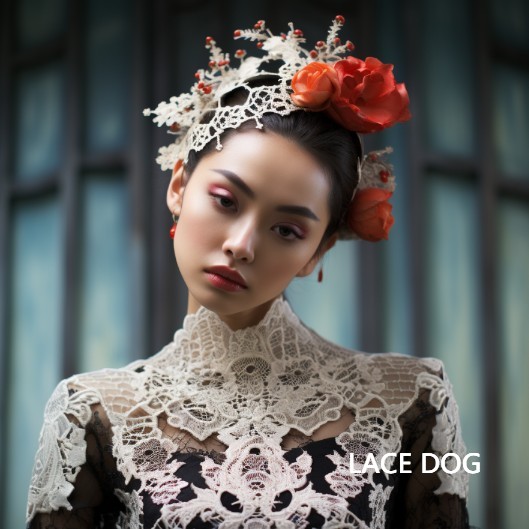
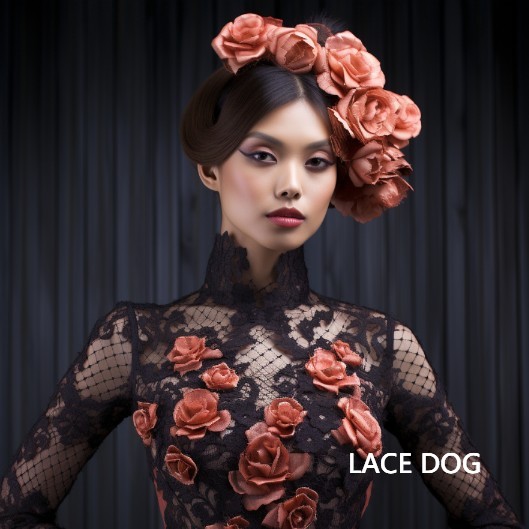

FAQs
- Q: Why is French lace so expensive?
- A: French lace is costly due to the high-quality materials used and the intricate hand-crafting techniques employed in its production. This labor-intensive process requires a high degree of skill and time, resulting in a luxurious and highly valued product.
- Q: What makes Indian lace unique?
- A: Indian lace reflects the country’s vibrant multiculturalism, often featuring bold patterns, a riot of colors, and a blend of cultural influences. However, the quality can vary greatly, sometimes even within the same batch, making it as unpredictable as a spicy Indian curry.
- Q: Is Turkish lace a good choice for budget-conscious designers?
- A: Yes, Turkish lace combines affordability with mass production. It offers a blend of stylistic diversity and high-volume availability that makes it appealing for budget-conscious designers.
- Q: Why is Swiss lace considered luxury?
- A: Swiss lace is known for its superb craftsmanship, high-quality materials, and meticulous precision, similar to the renowned Swiss timepieces. These factors, coupled with its high price point, position it as a luxury fabric.
- Q: How does Korean lace stand out in the global lace market?
- A: Korean lace stands out through its integration of modern technology with traditional techniques, and its ability to respond swiftly to fashion trends. While it may not have the historic prestige of European lace, it is known for its high-quality synthetic laces.
- Q: What are the challenges faced by the Chinese lace industry?
- A: While China is known for its mass production capabilities and competitive pricing, challenges include inconsistent quality, concerns about labor conditions, and a perception of lower quality compared to European lace.
- Q: Can I find a similar quality of lace as French lace but at a more affordable price?
- A: While French lace is highly esteemed, countries like Turkey and India produce lace at a more affordable price range. However, there might be variations in design intricacy and consistency of quality.
- Q: Is it possible to get custom-made lace designs?
- A: Yes, many manufacturers and artisans around the world offer custom-made lace designs. However, this service might come at a higher price and longer production time due to the additional work involved.
- Q: Which lace is best for my wedding dress?
- A: The choice of lace for your wedding dress depends on your personal style, budget, and the design of the dress. French and Swiss laces are often associated with luxury bridal wear, but Turkish, Indian, Korean, and Chinese laces also offer a variety of beautiful options.
- Q: What steps are lace manufacturers taking to address environmental concerns?
- A: Some manufacturers are adopting more sustainable practices, such as using organic cotton or natural dyes, improving water management, and reducing energy consumption. However, the extent of these practices varies widely across the industry and different countries.
